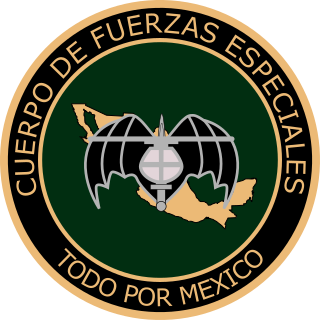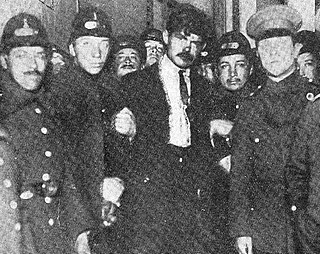
The National Liberation Army is a Marxist–Leninist guerrilla group involved in the continuing Colombian conflict, which has existed in Colombia since 1964. The ELN advocate a composite communist ideology of Marxism-Leninism and liberation theology. In 2013, it was estimated that the ELN forces consisted of between 1,380 and 3,000 guerrillas. According to former ELN national directorate member Felipe Torres, one fifth of ELN supporters have taken up arms. The ELN has been classified as a terrorist organization by the governments of Colombia, United States, Canada the European Union and Venezuela's National Assembly.

The Mexican Special Forces Corps are the special forces battalions of the Mexican Army. Formerly the Special Forces Airmobile Group (Spanish: Grupo Aeromóvil de Fuerzas Especiales) or GAFE, the SF corps has six regular battalions; plus four specialized units, one of those units is the Fuerza Especial de Reaccion, the other three remain secretive for the public; the motto of the SF Corps is Todo por México.

On August 25, 2011, members of drug cartel Los Zetas set a casino on fire in Monterrey, Nuevo León, Mexico, killing 52 people.
A series of bomb attacks, which continued as of 2014 with about 200 bombs up to that date, started in the capital of Chile, Santiago, in 2005.
Terrorism in Argentina has occurred since at least the 1970s, especially during the Argentinian Dirty War, where a number of terror acts occurred, with support of both the democratic government of Juan Perón, Isabel Perón and the following de facto government of the National Reorganization Process. In the 1990s, two major terrorist attacks occurred in Buenos Aires, which together caused 115 deaths and left at least 555 injured.
The 153rd Mixed Brigade was a unit of the Spanish Civil War that took part in the Spanish Civil War. Formed around the old Land and Freedom Column, the unit took part in the battles of Belchite, Aragon and Segre.
The Anarchic Cell For Revolutionary Solidarity was an anarchist urban guerrilla group that was active in the city of La Paz, where it carried out several explosive attacks in the first half of 2012, causing material damage.
The Mariano Sánchez Añón Insurrectional Cell was an urban guerrilla group in the Greater Mexico City area.

The Práxedis G. Guerrero Autonomous Cells of Immediate Revolution was an urban guerrilla group that centered its attacks in the metropolitan area of the Valley of Mexico, extending some attacks to neighboring states. This group, along with a dozen other cells, came to be considered a serious threat to the stability of the Mexican capital according to publications made by CISEN.
The Revolutionary Cells were an urban guerrilla group created in mid-2009 in the metropolitan area of Buenos Aires, being responsible for several arson attacks and explosive attacks against government buildings, transnational offices and "bourgeois structures".

The Severino di Giovanni Antipatriot Band was an urban guerrilla in Santiago, responsible for several arson attacks and explosives. The name was inspired by Severino di Giovanni, an Italian anarchist, journalist, worker and poet who died in Buenos Aires in 1931.

The Efraín Plaza Olmedo Dynamite Band, also known as the Dynamite Gang, was an urban guerrilla group active in Santiago, and known for its attacks against banks and the Hotel Marriott Santiago de Chile. The group named themselves after Efraín Plaza Olmedo, a Chilean anarchist responsible for a shooting that on July 14, 1912, fired at a crowd in the heart of Santiago, killing 2 young men from the wealthy class. He justified his attack as "a way to attract the attention of the people for their misery and the egotism of the bourgeoisie." He was sentenced to 40 years in prison. He was released in 1925, but was found dead days later without knowing if it was a suicide or if he was murdered.

The Antagonic Nuclei of the New Urban Guerrilla is a Chilean armed group created in mid-2011, active in the Santiago Metropolitan Region attached to insurrectionary anarchist theories, being responsible for several attacks in recent years.

Individualists Tending to the Wild is a self-defined eco-extremist group that emerged in Mexico in 2011. The Mexican authorities have attributed some violent actions to it, but most of the attacks claimed by the group have been denied after judicial investigations and attributed to other groups or crimes other than terrorism. The lack of a task of contrasting information by the media has led to any violent action claimed by ITS reaching public opinion.
The Vandalika Teodoro Suárez Gang was an Argentine urban guerrilla group active in the metropolitan area of Buenos Aires, from 2010 to 2011, where it launched attacks on banks and offices belonging to private companies.
The Friends of the Earth was an urban guerrilla group from Buenos Aires, known for perpetrating arson attacks against public and private vehicles.
The Iconoclastic Caravans for Free Will were an anarchist cell active in the Santiago Metropolitan Region, being known for some attacks in the communes of Las Condes and Vitacura. The group gained attention from the authorities for its members being closely investigated during the investigation of the Bombas Case.
The Jean Marc Rouillan Armed and Soulless Columns was an urban guerrilla group created in 2008 in the Santiago Metropolitan Area, responsible for some attacks with explosives. The group gained notoriety when it was investigated by the authorities in relation to the "bomb case".
The Leon Czolgosz Autonomous and Destructive Forces, were a Chilean anarchist cell formed in September 2006, known for its attacks against the National Intelligence Agency of Chile and the British embassy in Chile. The name of the group was in honor of the American anarchist Leon Czolgosz, who on September 6, 1901 assassinated then-United States President William McKinley with two bullets at point-blank range.

The Revolutionary Anarchist Front was an urban guerrilla group that was active in the Santiago Metropolitan Area, responsible for various sabotage, arson and explosive attacks. The group gained media attention for the attacks it carried out and was awarded.











